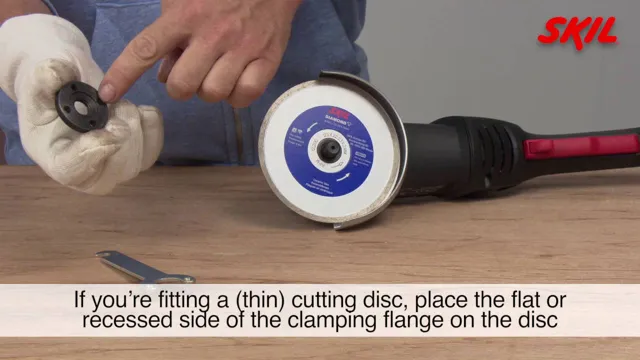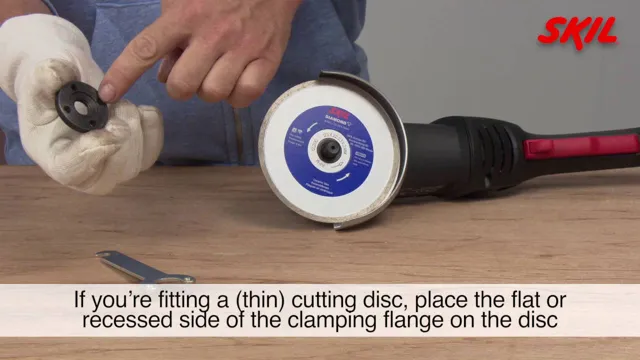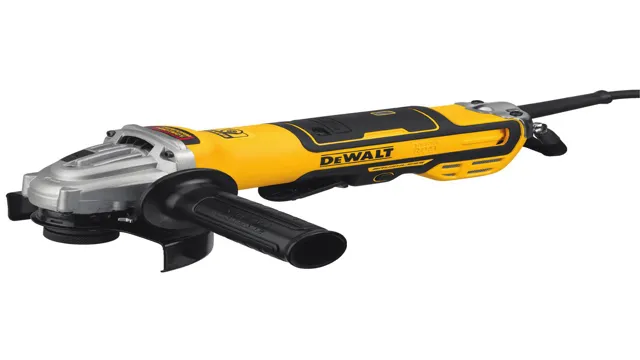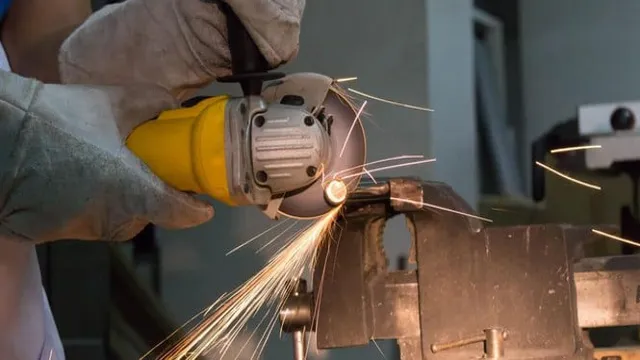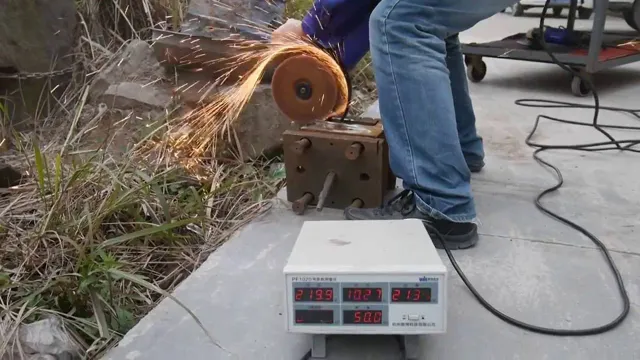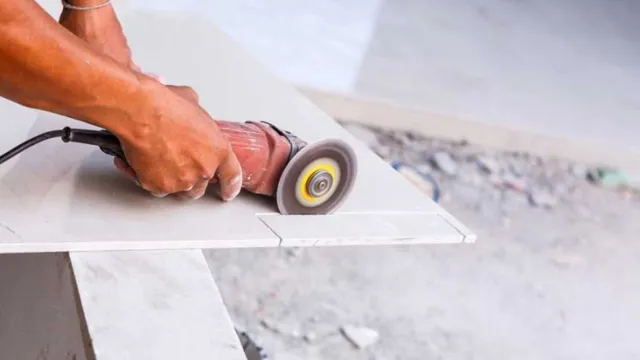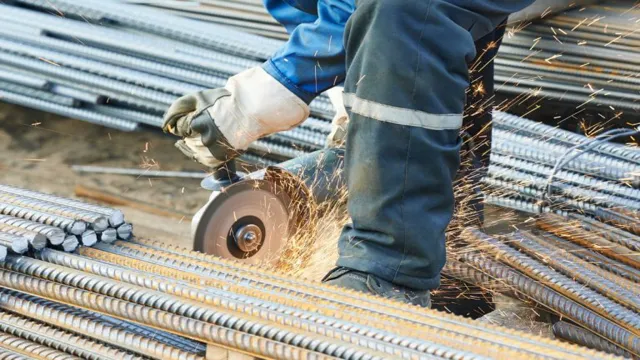How to cut cast iron pipe with an angle grinder: A beginner’s guide to clean cuts
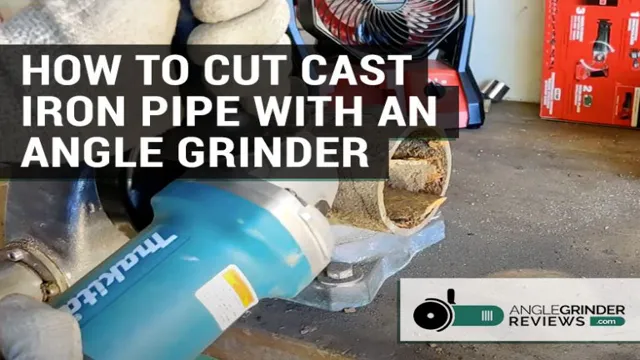
If you’re looking to cut through cast iron pipes, you might be wondering what the best method is. Many people opt for a reciprocating saw or hacksaw, but have you considered using an angle grinder? With the right blade and technique, an angle grinder can be an excellent tool for cutting cast iron pipes. But before you start grinding away, there are a few things you should know.
First, cast iron pipes can be brittle and may crack if too much pressure is applied. Second, cutting cast iron generates a lot of dust and debris, so you’ll want to take adequate safety precautions. One of the biggest advantages of using an angle grinder is that it allows you to make precise cuts with control.
You can choose between a variety of blades, each suited to a specific task. For example, a diamond blade is perfect for cutting through cast iron, whereas a metal cutting blade might be better suited to cutting steel pipes. When using an angle grinder, it’s important to keep a firm grip on the tool and make slow, steady cuts.
You want to avoid pushing too hard or jerking the grinder, as this could cause it to kick back or damage the blade. It’s also a good idea to wear safety gloves, eye protection, and a face mask to protect yourself from flying debris. In short, cutting cast iron pipes with an angle grinder is a viable option as long as you take the appropriate safety measures and use the right blade.
With a bit of practice, you’ll be able to make clean, precise cuts and get the job done efficiently.
Introduction
Cutting cast iron pipes can be a daunting task, especially if you don’t have the right tools for the job. One tool that can make this job easier is an angle grinder. An angle grinder is a multi-purpose tool that can be used for grinding, sanding, and cutting through various materials.
To cut a cast iron pipe with an angle grinder, you’ll need to have the right cutting disc or blade that’s capable of cutting through cast iron without breaking or shattering. It’s also important to make sure you have the proper safety gear, such as gloves and eye protection, to prevent any injuries or accidents during the cutting process. Remember to take your time and apply even pressure when cutting to ensure a smooth and straight cut.
With the right tools, technique, and safety precautions, you can easily cut through a cast iron pipe with an angle grinder.
Why Use an Angle Grinder to Cut Cast Iron Pipe?
If you are looking for an efficient way to cut cast iron pipes, then an angle grinder may be just the tool for you. Cast iron pipes can be challenging to cut due to their hard and brittle nature. However, an angle grinder equipped with a metal-cutting blade can make the job much easier.
This tool’s powerful motor and abrasive disc make it ideal for cutting through even the toughest of materials, including cast iron. Plus, using an angle grinder is more precise than using a hacksaw or other hand tools, ensuring straight cuts with minimal effort. So if you need to cut cast iron pipes for a DIY project or plumbing repair, consider using an angle grinder for a quick and efficient solution.
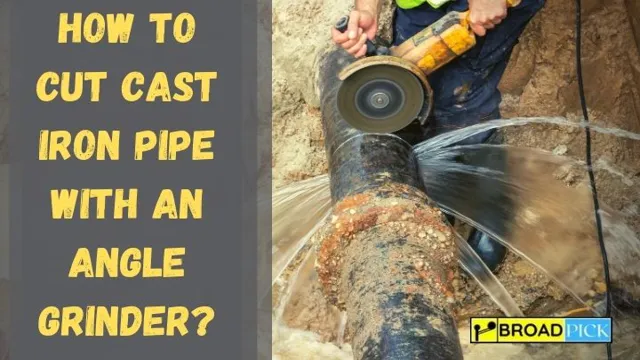
What You’ll Need
If you’re interested in starting a new project or hobby, you might be wondering what you’ll need to get started. Depending on the activity, there can be many different tools and materials required, but don’t let that intimidate you! A little bit of research and preparation can go a long way in ensuring that you have everything you need to succeed. One important thing to consider is whether you’ll need any specialized equipment or supplies.
For example, if you’re starting a woodworking project, you’ll likely need access to tools like saws, sanders, and drills, as well as wood and other materials. On the other hand, if you’re starting a new fitness routine, you may just need comfortable workout clothes and a pair of good shoes. Whatever your project or hobby may be, taking the time to gather the right materials and tools will help set you up for success.
So, let’s dive in and explore what you’ll need to get started!
Steps
Cutting cast iron pipes can be a daunting task, especially if you don’t have the right tools or experience. However, if you have an angle grinder, you’re in luck! An angle grinder is a versatile tool that you can use to cut through different materials, including cast iron pipes. Here’s how to cut cast iron pipe with an angle grinder: Firstly, make sure you have the necessary safety gear, such as eye protection, earplugs, and gloves.
Then, mark the area where you want to cut using a chalk or marker. Next, attach the cutting wheel or disc to the angle grinder and adjust the guard to cover the blade. Place the angle grinder on the marked area and slowly start grinding through the pipe.
Be sure to apply even pressure and move the grinder back and forth until the pipe is completely cut. After cutting the pipe, use a file or sandpaper to smooth out any rough edges or burrs that may have formed. You can also use a wire wheel attachment to clean the area.
Finally, make sure to dispose of any debris and properly store the angle grinder and accessories. With these simple steps, you’ll be able to cut cast iron pipes with an angle grinder like a pro!
Step 1: Prepare Your Area and Tools
Before starting any DIY project, it’s important to prepare your area and tools. This ensures that you have everything you need at hand and that your workspace is clean and organized, which will make the process much easier and less stressful. When preparing your area, start by clearing the space you’ll be working in.
This includes removing any furniture, rugs, or other items that could get in the way. Then, lay down a drop cloth to protect your floor from any spills or drips. You should also gather all of the tools and materials you’ll need and place them within easy reach.
This can include things like a paintbrush, sandpaper, tape measure, and any other supplies specific to your project. Finally, make sure your tools are clean and in good working condition before you start. This will prevent any unnecessary delays or accidents.
By taking these simple steps, your DIY project will be off to a great start and you’ll be well on your way to success.
Step 2: Secure the Pipe in Place
Now that you’ve dug a trench and laid the pipe, it’s time to move on to the next step of the process and secure the pipe in place. One of the best ways to do this is by using pipe clamps or straps that are specifically designed to hold pipes securely. To begin, measure the distance between each clamp or strap and make sure they are evenly spaced apart.
Then, attach the clamps or straps to the wall or surface you are mounting them on. Once they’re in place, slide the pipe into the clamps or straps, making sure it’s positioned correctly. Tighten the screws on the clamps or straps until they are snug, but not too tight as this may damage the pipe.
It’s essential to ensure that the pipe is secured in place to prevent any movement or potential damage to the surrounding area. By using the proper tools and techniques to secure the pipe, you can guarantee that your project will run smoothly with as little disruption as possible.
Step 3: Choose the Right Wheel and Attach to the Grinder
Now that you have your angle grinder ready for action, it’s time to choose the right wheel and attach it to the grinder. Firstly, it’s essential to note that every wheel is designed for a specific purpose, and selecting the wrong one can lead to potential safety hazards and poor results. Therefore, you need to take your project’s requirements, material, and wheel specifications into account before settling on the wheel selection.
Common types of angle grinder wheels include grinding wheels, cut-off wheels, wire brushes, diamond wheels, and polishing wheels, among others. Once you know which wheel you need, attach it to the grinder following the manufacturer’s instructions, ensuring it is secure and tightly fastened. Remember to double-check that the wheel has no cracks or damage before beginning your task to avoid any potential accidents.
With the right wheel attached, you can run your grinder smoothly and safely while tackling your project with ease.
Step 4: Make the Cut
Now that you’ve marked your cutting position, it’s time to make the cut. This step requires precision and caution, so make sure you have all the necessary tools and equipment before you get started. A sharp chainsaw is a must-have as it will make clean cuts that won’t damage the tree.
Hold the chainsaw with both hands for better control and slowly guide it through the tree trunk. Make sure your cuts are straight and steady to prevent any accidents or mishaps. If you’re not confident with using a chainsaw, it’s best to seek the help of a professional arborist.
Remember to take your time and don’t rush the process, as your safety and the safety of those around you is of utmost importance. Once you’ve made the cut, leave enough of the trunk intact so that the tree can continue to grow without any problems. With these steps, you can ensure a successful tree removal process that’s not only safe but also beneficial for the environment.
Safety Tips
Cutting cast iron pipes can be challenging and even dangerous without the proper safety precautions. When using an angle grinder for cutting cast iron pipes, it is important to wear personal protective equipment such as safety glasses or goggles, a dust mask, and thick work gloves to prevent burns or abrasions. Additionally, make sure that the angle grinder is equipped with a diamond-cutting blade that can withstand the rigors of cast iron pipes.
It is also important to secure the cast iron pipe on a steady surface to prevent it from shaking or moving while cutting, as this can cause injury or damage to the blade. Remember to take breaks and avoid overworking the angle grinder, as well as taking extra care when cutting near corners or edges where the pipe may be thin or uneven. With these safety tips and precautions in mind, cutting through cast iron pipes with an angle grinder can be done successfully and safely.
Wear Appropriate Protective Gear
Protective gear is one of the most important things to consider when it comes to safety. Whenever you are engaging in any activity that could potentially harm you, it is essential that you wear the appropriate protective gear. This could be anything from a helmet, gloves, eyewear, to steel-toed boots.
While it might seem unnecessary, the truth is that these items can save you from a lot of injuries. For instance, if you are riding a bike or playing a contact sport, a helmet can protect your head from concussions or other head injuries. Similarly, gloves can prevent your hands from cuts and burns, while eyewear can keep your eyes safe from dust, debris, and other flying objects.
Steel-toed boots, on the other hand, can save your toes and feet from being crushed by heavy objects or machinery. In conclusion, before you start any activity, make sure you have the right protective gear to keep yourself safe.
Avoid Sparks and Fire Hazards
When it comes to fire hazards in the home or workplace, prevention is key. One of the best ways to avoid sparks and potential fires is to be mindful of your surroundings. For instance, electrical fires can be prevented by checking cords and outlets for wear and tear.
Additionally, avoiding overloading outlets or using extension cords as a permanent solution can help to reduce the risk of sparks. It’s also important to keep flammable materials away from heat sources and to extinguish candles or smoking materials before leaving the room. By keeping these safety tips in mind and using common sense, we can all do our part to promote fire safety and avoid the potential dangers of a spark or fire.
Conclusion
Cutting cast iron pipe with an angle grinder can be a grueling task, but with the proper equipment and technique, the job can be done with ease. Remember to wear protective gear, mark your cut with precision, and use the appropriate blade for the job. Whether you’re a seasoned DIYer or just starting out, it’s always important to work smart, not hard.
And with these tips in mind, you’ll be able to slice through that iron pipe like a hot knife through butter. So why settle for a rusty, outdated plumbing system? Take the plunge, make the cut, and upgrade to a modern, efficient design. Your home will thank you for it.
“
FAQs
What safety precautions should be taken when cutting cast iron pipes with an angle grinder?
Safety goggles and gloves should be worn to protect eyes and skin. A dust mask should also be worn to avoid inhaling harmful particles.
How should the angle grinder blade be selected for cutting cast iron pipes?
A diamond blade should be used for cutting cast iron pipes as it is stronger and more durable than other blades.
What is the best way to mark the cut line on a cast iron pipe for accurate cutting?
A marker or chalk can be used to mark the cut line on the pipe. A level can also be used to ensure the line is straight.
Can a regular angle grinder be used to cut cast iron pipes?
Yes, a regular angle grinder can be used for cutting cast iron pipes but it may not be as efficient as a diamond blade grinder.
How can the length of the cast iron pipe be accurately measured before cutting?
A measuring tape or ruler can be used to measure the length of the pipe before cutting. The measurement should be marked with a marker or chalk.
What is the proper technique for cutting cast iron pipes with an angle grinder?
The angle grinder should be held at a slight angle to the pipe while cutting. The cutting should be done in a slow and steady manner to avoid overheating the blade.
What are some common mistakes to avoid when cutting cast iron pipes with an angle grinder?
Some common mistakes to avoid include cutting too quickly or using too much pressure on the blade. Overheating the blade can also cause it to wear down quickly.

